Evaluation of the Water Cycle in the European COSMO-REA6 Reanalysis Using GRACE
Abstract
:1. Introduction
2. Data and Models
2.1. Study Area
2.2. GRACE
2.3. Numerical Weather Prediction Models
2.3.1. COSMO-REA6
2.3.2. ERA-Interim
2.3.3. MERRA-2
2.4. Observational Datasets
2.4.1. GPCC
2.4.2. GLEAM
2.5. Discharge
3. Methodology
3.1. Consistent Time Series of Atmospheric-Terrestrial Flux and Storage Change
3.2. Using GR2M-Snow for Generating Modeled Discharge Time Series
3.3. Evaluation of the Water Budget Equation
3.4. Error Assessment
4. Results
4.1. Modeled Discharge from GR2M-Snow
4.2. Time Series of Fluxes and Storage Change
4.3. Statistics of the River Basins
5. Discussion and Outlook
Acknowledgments
Author Contributions
Conflicts of Interest
References
- Reager, J.T.; Gardner, A.S.; Famiglietti, J.S.; Wiese, D.N.; Eicker, A.; Lo, M.H. A decade of sea level rise slowed by climate-driven hydrology. Science 2016, 351, 699–703. [Google Scholar] [CrossRef] [PubMed]
- Rietbroek, R.; Brunnabend, S.E.; Kusche, J.; Schröter, J.; Dahle, C. Revisiting the contemporary sea-level budget on global and regional scales. Proc. Natl. Acad. Sci. USA 2016, 113, 1504–1509. [Google Scholar] [CrossRef] [PubMed]
- Byrne, M.P.; O’Gorman, P.A. The Response of Precipitation Minus Evapotranspiration to Climate Warming: Why the “Wet-Get-Wetter, Dry-Get-Drier” Scaling Does Not Hold over Land. J. Clim. 2015, 28, 8078–8092. [Google Scholar] [CrossRef]
- Tapiador, F.J.; Turk, F.; Petersen, W.; Hou, A.Y.; García-Ortega, E.; Machado, L.A.; Angelis, C.F.; Salio, P.; Kidd, C.; Huffman, G.J.; et al. Global precipitation measurement: Methods, datasets and applications. Atmos. Res. 2012, 104–105, 70–97. [Google Scholar] [CrossRef]
- Wang, K.; Dickinson, R.E. A review of global terrestrial evapotranspiration: Observation, modeling, climatology, and climatic variability. Rev. Geophys. 2012, 50, RG2050. [Google Scholar] [CrossRef]
- Swenson, S.; Wahr, J. Estimating Large-Scale Precipitation Minus Evapotranspiration from GRACE Satellite Gravity Measurements. J. Hydrometeorol. 2006, 7, 252–270. [Google Scholar] [CrossRef]
- Lorenz, C.; Kunstmann, H. The Hydrological Cycle in Three State-of-the-Art Reanalyses: Intercomparison and Performance Analysis. J. Hydrometeorol. 2012, 13, 1397–1420. [Google Scholar] [CrossRef]
- Springer, A.; Kusche, J.; Hartung, K.; Ohlwein, C.; Longuevergne, L. New Estimates of Variations in Water Flux and Storage over Europe Based on Regional (Re)Analyses and Multisensor Observations. J. Hydrometeorol. 2014, 15, 2397–2417. [Google Scholar] [CrossRef]
- Bollmeyer, C.; Keller, J.D.; Ohlwein, C.; Wahl, S.; Crewell, S.; Friederichs, P.; Hense, A.; Keune, J.; Kneifel, S.; Pscheidt, I.; et al. Towards a high-resolution regional reanalysis for the European CORDEX domain. Q. J. R. Meteorol. Soc. 2015, 141, 1–15. [Google Scholar] [CrossRef]
- Hirschi, M.; Viterbo, P.; Seneviratne, S.I. Basin-scale water-balance estimates of terrestrial water storage variations from ECMWF operational forecast analysis. Geophys. Res. Lett. 2006, 33, L21401. [Google Scholar] [CrossRef]
- Seitz, F.; Schmidt, M.; Shum, C. Signals of extreme weather conditions in Central Europe in GRACE 4-D hydrological mass variations. Earth Planet. Sci. Lett. 2008, 268, 165–170. [Google Scholar] [CrossRef]
- Sahoo, A.K.; Pan, M.; Troy, T.J.; Vinukollu, R.K.; Sheffield, J.; Wood, E.F. Reconciling the global terrestrial water budget using satellite remote sensing. Remote Sens. Environ. 2011, 115, 1850–1865. [Google Scholar] [CrossRef]
- Ramillien, G.; Frappart, F.; Güntner, A.; Ngo-Duc, T.; Cazenave, A.; Laval, K. Time variations of the regional evapotranspiration rate from Gravity Recovery and Climate Experiment (GRACE) satellite gravimetry. Water Resour. Res. 2006, 42, W10403. [Google Scholar] [CrossRef]
- Rodell, M.; McWilliams, E.B.; Famiglietti, J.S.; Beaudoing, H.K.; Nigro, J. Estimating evapotranspiration using an observation based terrestrial water budget. Hydrol. Processes 2011, 25, 4082–4092. [Google Scholar] [CrossRef]
- Cesanelli, A.; Guarracino, L. Estimation of regional evapotranspiration in the extended Salado Basin (Argentina) from satellite gravity measurements. Hydrogeol. J. 2011, 19, 629–639. [Google Scholar] [CrossRef]
- Berrisford, P.; Dee, D.; Poli, P.; Brugge, R.; Fielding, K.; Fuentes, M.; Kåallberg, P.; Kobayashi, S.; Uppala, S.; Simmons, A. ERA Report Series (Version 2.0), European Centre for Medium Range Weather Forecasts. 2011. Available online: http://www.ecmwf.int/en/elibrary/8174-era-interim-archive-version-20 (accessed on 23 February 2017).
- McCarty, W.; Coy, L.; Gelaro, R.; Huang, A.; Merkova, D.; Smith, E.B.; Sienkiewicz, M.; Wargan, K. MERRA-2 Input Observations: Summary and Assessment 2016. Available online: https://gmao.gsfc.nasa.gov/pubs/docs/McCarty885.pdf (accessed on 22 February 2017).
- Schneider, U.; Becker, A.; Finger, P.; Meyer-Christoffer, A.; Rudolf, B.; Ziese, M. GPCC Full Data Reanalysis Version 7.0 at 0.5°: Monthly Land-Surface Precipitation from Rain-Gauges Built on GTS-Based and Historic Data. 2015. Available online: http://doi.org/10.5676/DWD_GPCC/FD_M_V7_050 (accessed on 1 January 2017).
- Miralles, D.G.; Holmes, T.R.H.; De Jeu, R.A.M.; Gash, J.H.; Meesters, A.G.C.A.; Dolman, A.J. Global land-surface evaporation estimated from satellite-based observations. Hydrol. Earth Syst. Sci. 2011, 15, 453–469. [Google Scholar] [CrossRef]
- Martens, B.; Miralles, D.G.; Lievens, H.; van der Schalie, R.; de Jeu, R.A.M.; Férnandez-Prieto, D.; Beck, H.E.; Dorigo, W.A.; Verhoest, N.E.C. GLEAM v3: Satellite-based land evaporation and root-zone soil moisture. Geosci. Model Dev. Discuss. 2016, 2016, 1–36. [Google Scholar] [CrossRef]
- Birkinshaw, S.J.; O’Donnell, G.M.; Moore, P.; Kilsby, C.G.; Fowler, H.J.; Berry, P.A.M. Using satellite altimetry data to augment flow estimation techniques on the Mekong River. Hydrol. Processes 2010, 24, 3811–3825. [Google Scholar] [CrossRef]
- Tourian, M.J.; Tarpanelli, A.; Elmi, O.; Qin, T.; Brocca, L.; Moramarco, T.; Sneeuw, N. Spatiotemporal densification of river water level time series by multimission satellite altimetry. Water Resour. Res. 2016, 52, 1140–1159. [Google Scholar] [CrossRef]
- Tarpanelli, A.; Brocca, L.; Lacava, T.; Melone, F.; Moramarco, T.; Faruolo, M.; Pergola, N.; Tramutoli, V. Toward the estimation of river discharge variations using MODIS data in ungauged basins. Remote Sens. Environ. 2013, 136, 47–55. [Google Scholar] [CrossRef]
- Sichangi, A.W.; Wang, L.; Yang, K.; Chen, D.; Wang, Z.; Li, X.; Zhou, J.; Liu, W.; Kuriaa, D. Estimating continental river basin discharges using multiple remote sensing data sets. Remote Sens. Environ. 2016, 179, 36–53. [Google Scholar] [CrossRef]
- Mouelhi, S. Vers une Chaîne Cohérente de Modèles Pluie-Débit aux pas de Temps Pluriannuel, Annuel, Mensuel et Journalier. Ph.D. Thesis, ENGREF (AgroParisTech), Paris, France, 2003. Available online: http://hydrologie.org/THE/MOUELHI.pdf (accessed on 22 February 2017).
- Tapley, B.D.; Bettadpur, S.; Watkins, M.; Reigber, C. The gravity recovery and climate experiment: Mission overview and early results. Geophys. Res. Lett. 2004, 31, L09607. [Google Scholar] [CrossRef]
- Wahr, J.; Molenaar, M.; Bryan, F. Time variability of the Earth’s gravity field: Hydrological and oceanic effects and their possible detection using GRACE. J. Geophys. Res. 1998, 103, 30205–30229. [Google Scholar] [CrossRef]
- Dahle, C.; Flechtner, F.; Gruber, C.; König, D.; König, R.; Michalak, G.; Neumayer, K.H. GFZ GRACE Level-2 Processing Standards Document for Level-2 Product Release 0005. Scientific Technical Report STR12/02—Data, Revised Edition. 2012. Available online: http://dx.doi.org/10.2312/GFZ.b103-1202-25 (accessed on 15 January 2013).
- Kusche, J. Approximate decorrelation and non-isotropic smoothing of time-variable GRACE-type gravity field models. J. Geodesy 2007, 81, 733–749. [Google Scholar] [CrossRef]
- Rietbroek, R.; Fritsche, M.; Brunnabend, S.E.; Daras, I.; Kusche, J.; Schröter, J.; Flechtner, F.; Dietrich, R. Global surface mass from a new combination of GRACE, modelled OBP and reprocessed GPS data. J. Geodyn. 2012, 59–60, 64–71. [Google Scholar] [CrossRef]
- Rietbroek, R.; Brunnabend, S.E.; Kusche, J.; Schröter, J. Resolving sea level contributions by identifying fingerprints in time-variable gravity and altimetry. J. Geodyn. 2012, 59–60, 72–81. [Google Scholar] [CrossRef]
- Cheng, M.; Tapley, B.D.; Ries, J.C. Deceleration in the Earth’s oblateness. J. Geophys. Res. 2013, 118, 740–747. [Google Scholar] [CrossRef]
- Geruo, A.; Wahr, J.; Zhong, S. Computations of the viscoelastic response of a 3-D compressible Earth to surface loading: An application to Glacial Isostatic Adjustment in Antarctica and Canada. Geophys. J. Int. 2013, 192, 557. [Google Scholar]
- Mesinger, F.; DiMego, G.; Kalnay, E.; Mitchell, K.; Shafran, P.C.; Ebisuzaki, W.; Jović, D.; Woollen, J.; Rogers, E.; Berbery, E.H.; et al. North American Regional Reanalysis. Bull. Am. Meteorol. Soc. 2006, 87, 343–360. [Google Scholar] [CrossRef]
- Bromwich, D.H.; Wilson, A.B.; Bai, L.; Moore, G.W.K.; Bauer, P. Special Issue Article. Q. J. R. Meteorol. Soc. 2016, 142, 644–658. [Google Scholar] [CrossRef]
- Jermey, P.M.; Renshaw, R.J. Precipitation representation over a two-year period in regional reanalysis. Q. J. R. Meteorol. Soc. 2016, 142, 1300–1310. [Google Scholar] [CrossRef]
- Dahlgren, P.; Landelius, T.; Kållberg, P.; Gollvik, S. A high-resolution regional reanalysis for Europe. Part 1: Three-dimensional reanalysis with the regional HIgh-Resolution Limited-Area Model (HIRLAM). Q. J. R. Meteorol. Soc. 2016, 142, 2119–2131. [Google Scholar] [CrossRef]
- Baldauf, M.; Seifert, A.; Förstner, J.; Majewski, D.; Raschendorfer, M.; Reinhardt, T. Operational Convective-Scale Numerical Weather Prediction with the COSMO Model: Description and Sensitivities. Mon. Weather Rev. 2011, 139, 3887–3905. [Google Scholar] [CrossRef]
- Schraff, C.; Hess, R. A Description of the Nonhydrostatic Regional COSMO-Model; Part III: Data Assimilation; Deutscher Wetterdienst: Offenbach, Germany, 2012. [Google Scholar]
- Wahl, S.; Bollmeyer, C.; Crewell, S.; Figura, C.; Friederichs, P.; Hense, A.; Keller, J.D.; Ohlwein, C. A novel convective-scale regional reanalyses COSMO-REA2: Improving the representation of precipitation. Meteorol. Z. 2017. [Google Scholar] [CrossRef]
- Dee, D.P.; Uppala, S.M.; Simmons, A.J.; Berrisford, P.; Poli, P.; Kobayashi, S.; Andrae, U.; Balmaseda, M.A.; Balsamo, G.; Bauer, P.; et al. The ERA-Interim reanalysis: Configuration and performance of the data assimilation system. Q. J. R. Meteorol. Soc. 2011, 137, 553–597. [Google Scholar] [CrossRef]
- Reichle, R.H.; Liu, Q. Observation-Corrected Precipitation Estimates in GEOS-5 2014. Available online: https://ntrs.nasa.gov/search.jsp?R=20150000725 (accessed on 22 February 2017).
- Reichle, R.H.; Liu, Q.; Koster, R.D.; Draper, C.S.; Mahanama, S.P.P.; Partyka, G.S. Land Surface Precipitation in MERRA-2. J. Clim. 2017, 30, 1643–1664. [Google Scholar] [CrossRef]
- Schneider, U.; Becker, A.; Finger, P.; Meyer-Christoffer, A.; Ziese, M.; Rudolf, B. GPCC’s new land surface precipitation climatology based on quality-controlled in situ data and its role in quantifying the global water cycle. Theor. Appl. Climatol. 2014, 115, 15–40. [Google Scholar] [CrossRef]
- Priestley, C.H.B.; Taylor, R.J. On the Assessment of Surface Heat Flux and Evaporation Using Large-Scale Parameters. Mon. Weather Rev. 1972, 100, 81–92. [Google Scholar] [CrossRef]
- Sneeuw, N.; Lorenz, C.; Devaraju, B.; Tourian, M.J.; Riegger, J.; Kunstmann, H.; Bárdossy, A. Estimating Runoff Using Hydro-Geodetic Approaches. Surv. Geophys. 2014, 35, 1333–1359. [Google Scholar] [CrossRef]
- Mouelhi, S.; Michel, C.; Perrin, C.; Andréassian, V. Stepwise development of a two-parameter monthly water balance model. J. Hydrol. 2006, 318, 200–214. [Google Scholar] [CrossRef]
- Swenson, S.; Wahr, J. Methods for inferring regional surface-mass anomalies from Gravity Recovery and Climate Experiment (GRACE) measurements of time-variable gravity. J. Geophys. Res. 2002, 107, ETG 3-1–ETG 3-13. [Google Scholar] [CrossRef]
- Longuevergne, L.; Scanlon, B.R.; Wilson, C.R. GRACE Hydrological estimates for small basins: Evaluating processing approaches on the High Plains Aquifer, USA. Water Resour. Res. 2010, 46, W11517. [Google Scholar] [CrossRef]
- Haylock, M.R.; Hofstra, N.; Klein Tank, A.M.G.; Klok, E.J.; Jones, P.D.; New, M. A European daily high-resolution gridded data set of surface temperature and precipitation for 1950–2006. J. Geophys. Res. 2008, 113, D20119. [Google Scholar] [CrossRef]
- Harris, I.; Jones, P.; Osborn, T.; Lister, D. Updated high-resolution grids of monthly climatic observations—The CRU TS3.10 Dataset. Int. J. Climatol. 2014, 34, 623–642. [Google Scholar] [CrossRef]
- Gudmundsson, L.; Seneviratne, S.I. Observation-based gridded runoff estimates for Europe (E-RUN version 1.1). Earth Syst. Sci. Data 2016, 8, 279–295. [Google Scholar] [CrossRef]
- Nash, J.; Sutcliffe, J. River flow forecasting through conceptual models part I—A discussion of principles. J. Hydrol. 1970, 10, 282–290. [Google Scholar] [CrossRef]
- Bach, L.; Schraff, C.; Keller, J.D.; Hense, A. Towards a probabilistic regional reanalysis system for Europe: Evaluation of precipitation from experiments. Tellus A Dyn. Meteorol. Oceanogr. 2016, 68, 32209. [Google Scholar] [CrossRef]
- Stahl, K.; Tallaksen, L.M.; Hannaford, J.; van Lanen, H.A.J. Filling the white space on maps of European runoff trends: Estimates from a multi-model ensemble. Hydrol. Earth Syst. Sci. 2012, 16, 2035–2047. [Google Scholar] [CrossRef]
- Greve, P.; Orlowsky, B.; Mueller, B.; Sheffield, J.; Reichstein, M.; Seneviratne, S.I. Global assessment of trends in wetting and drying over land. Nat. Geosci. 2014, 7, 716–721. [Google Scholar] [CrossRef]
- Syed, T.H.; Famiglietti, J.S.; Chambers, D.P. GRACE-Based Estimates of Terrestrial Freshwater Discharge from Basin to Continental Scales. J. Hydrometeorol. 2009, 10, 22–40. [Google Scholar] [CrossRef]
- Fersch, B.; Kunstmann, H.; Bárdossy, A.; Devaraju, B.; Sneeuw, N. Continental-Scale Basin Water Storage Variation from Global and Dynamically Downscaled Atmospheric Water Budgets in Comparison with GRACE-Derived Observations. J. Hydrometeorol. 2012, 13, 1589–1603. [Google Scholar] [CrossRef]

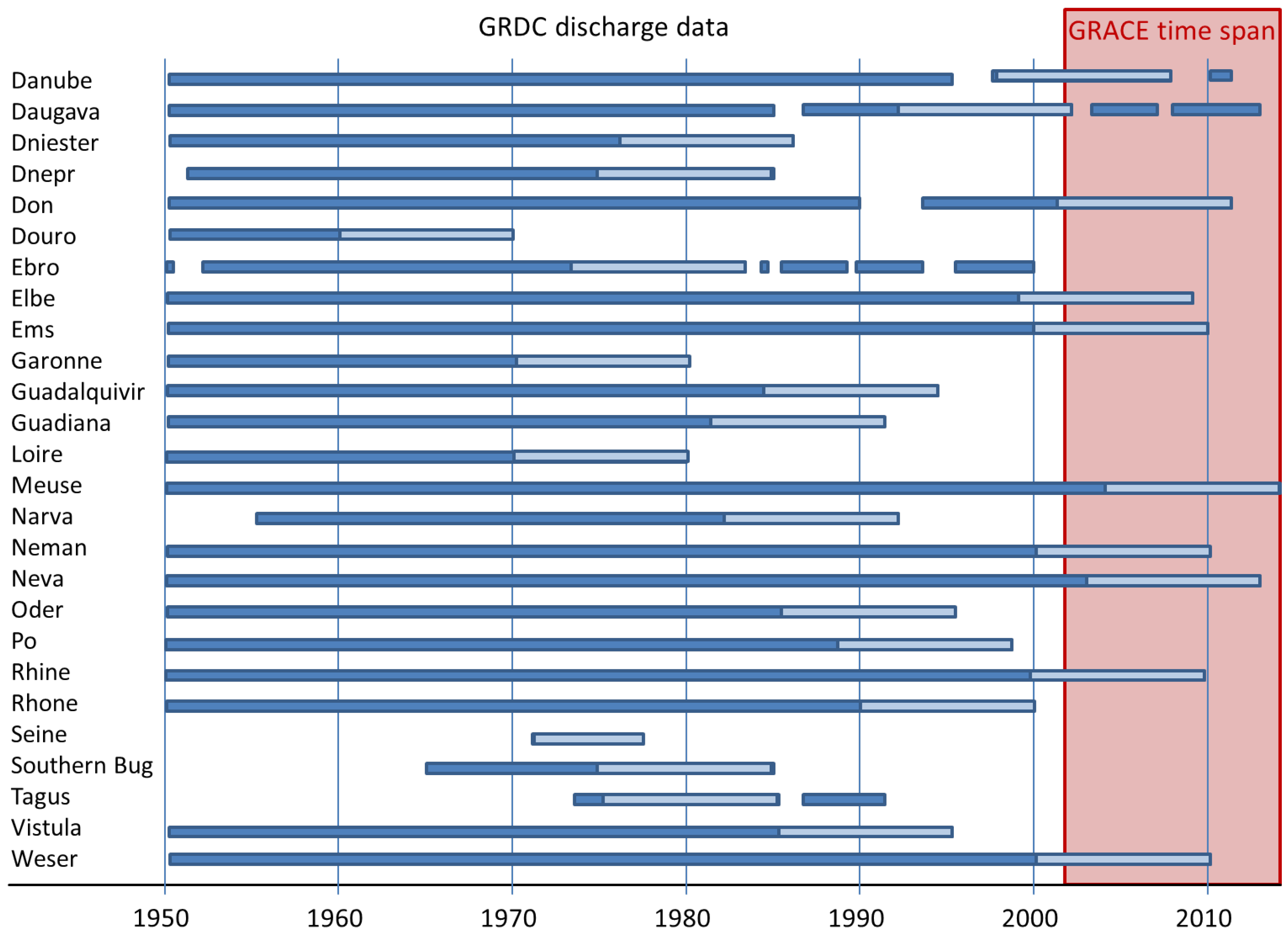

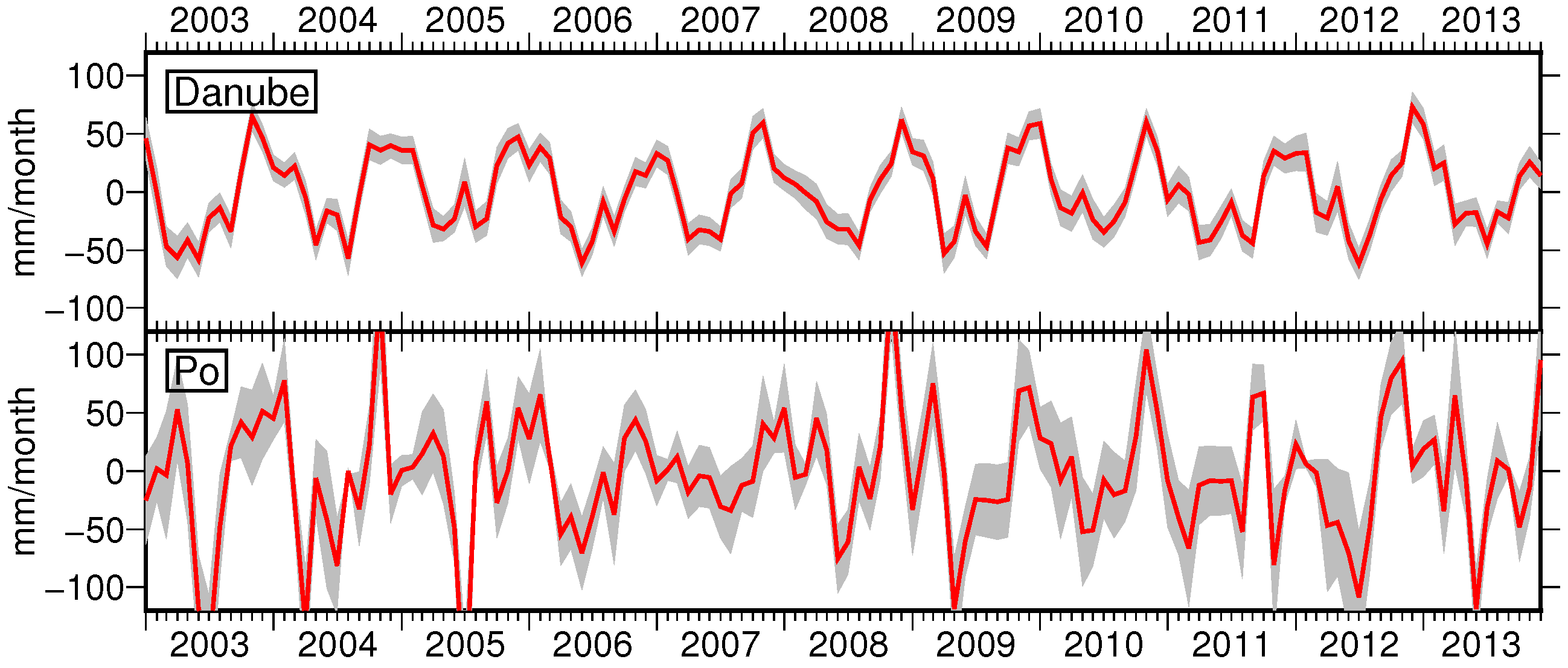
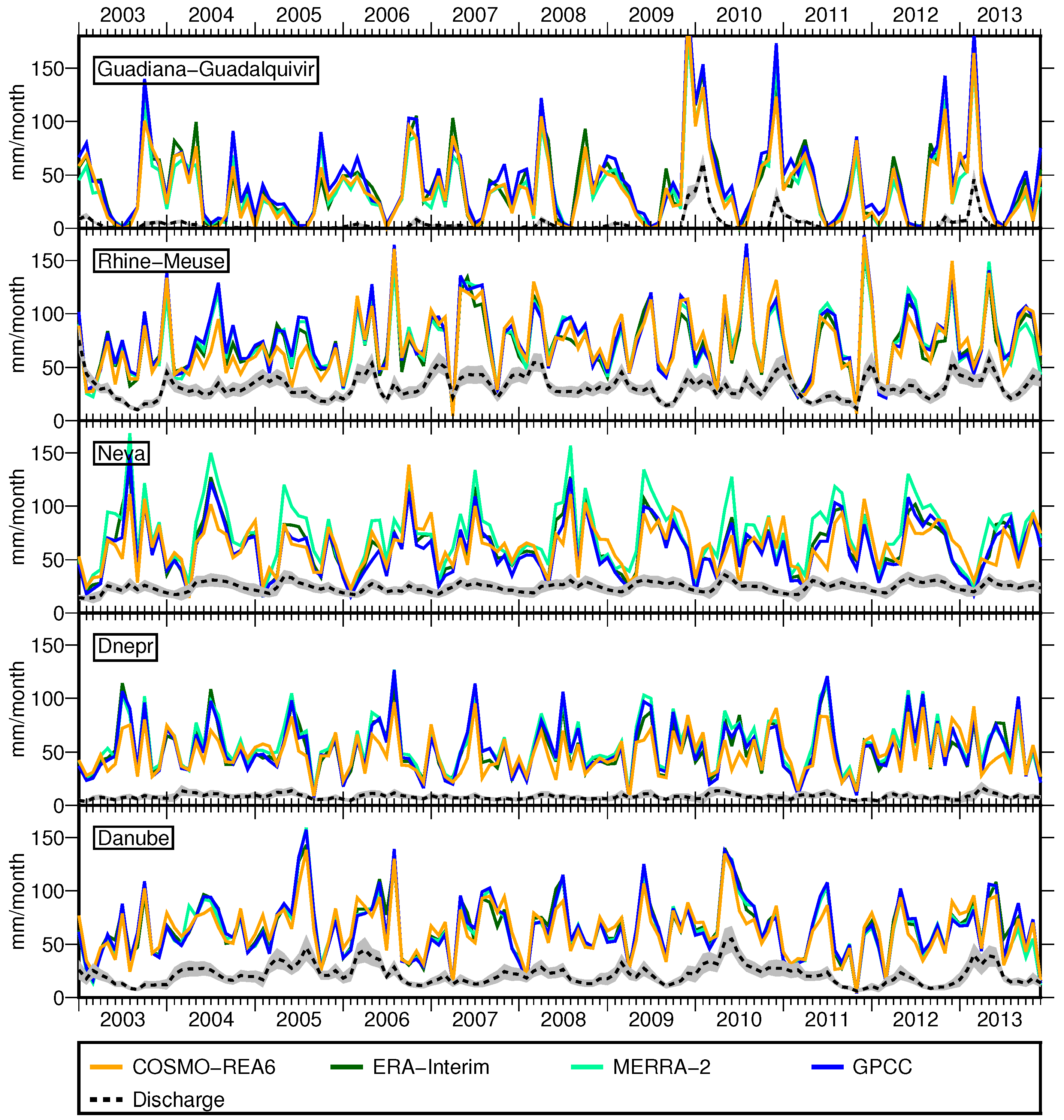
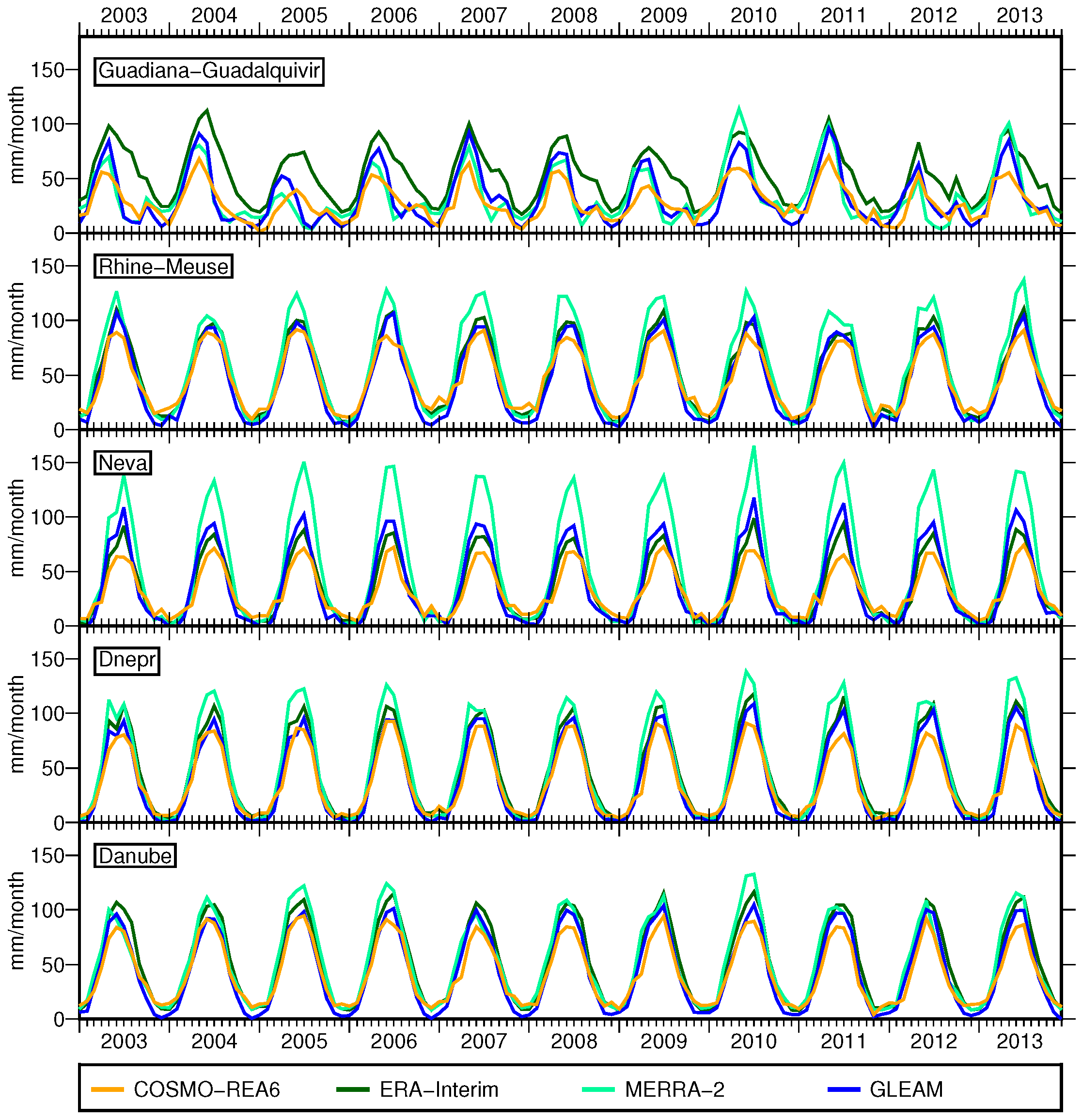
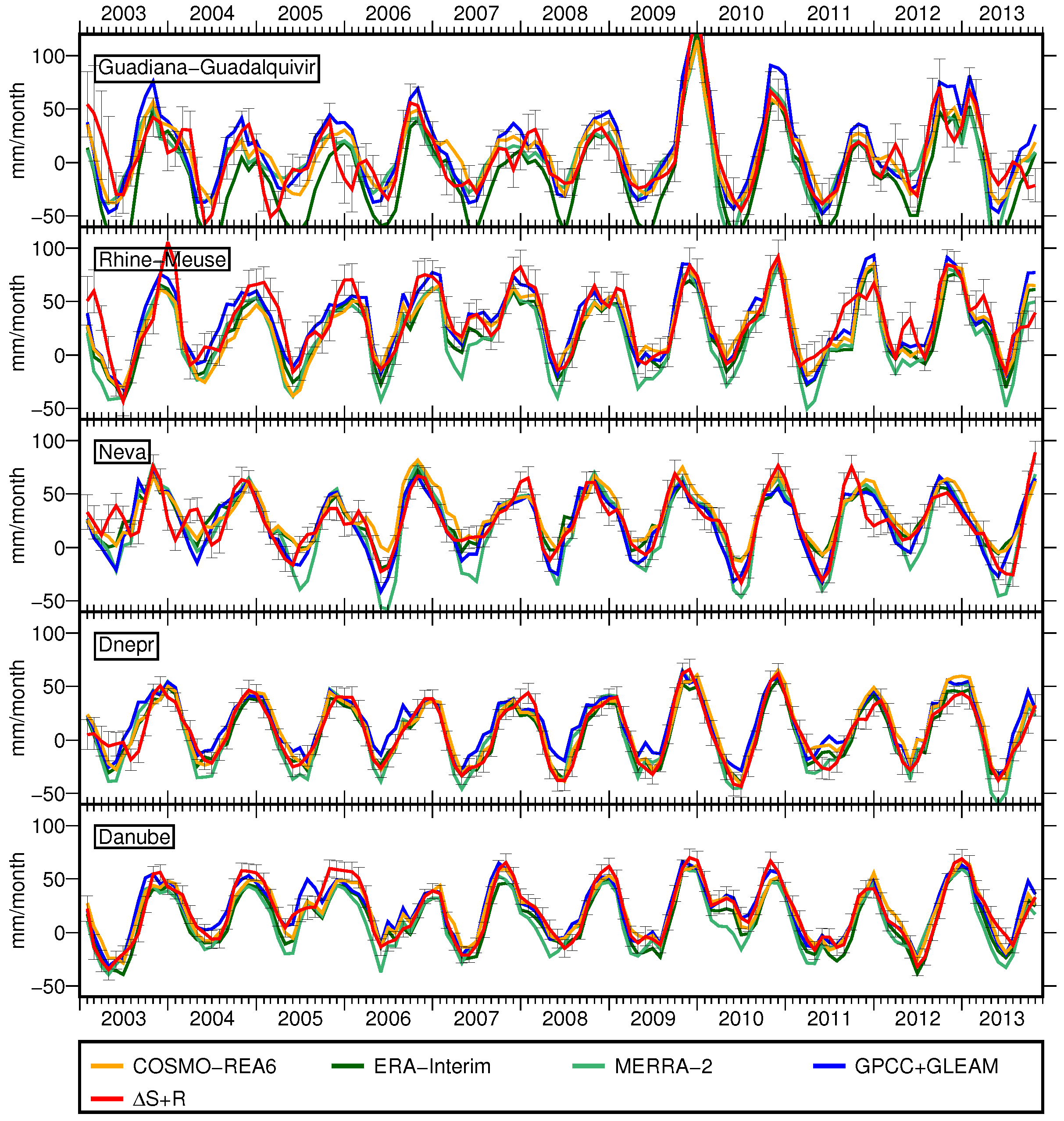


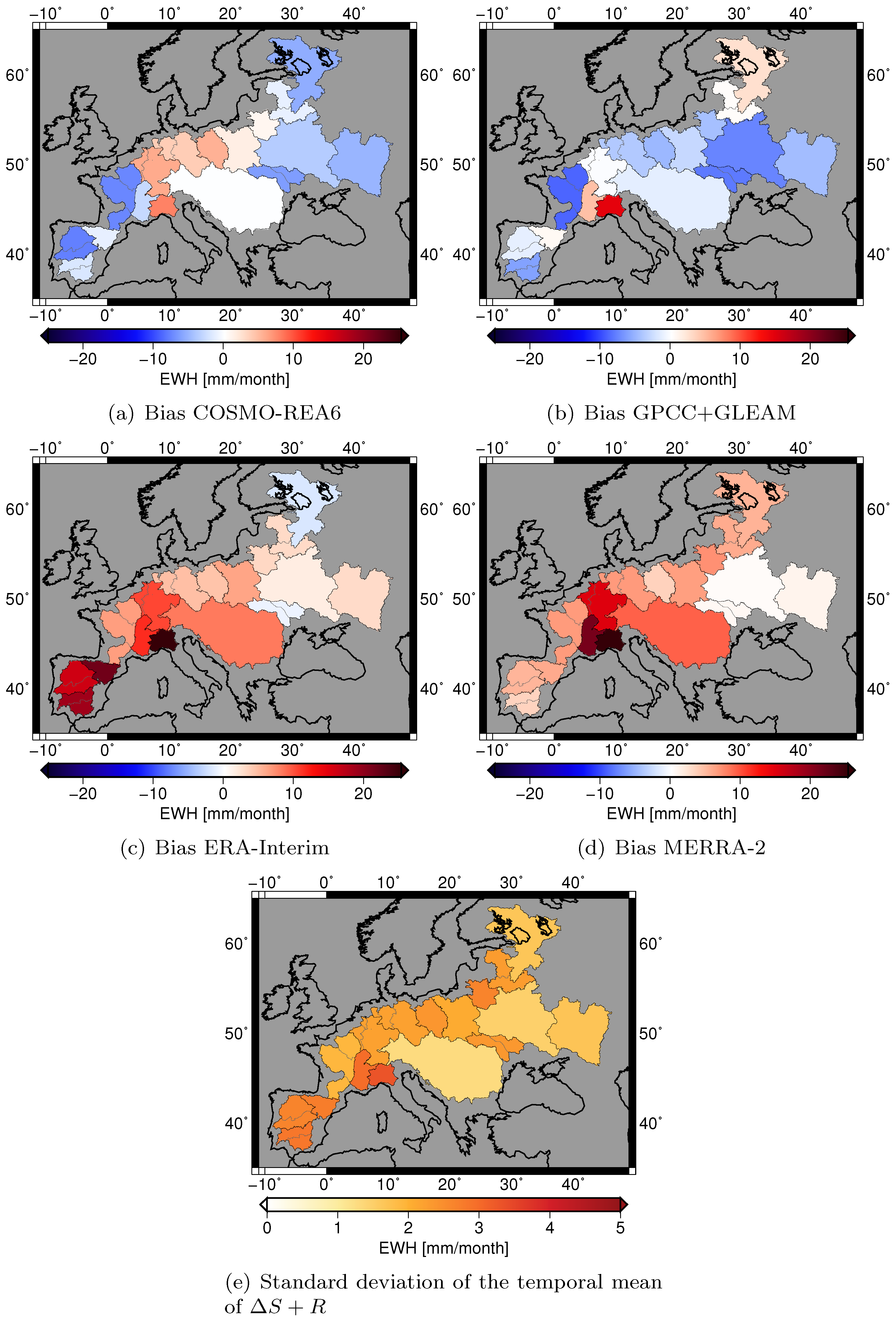

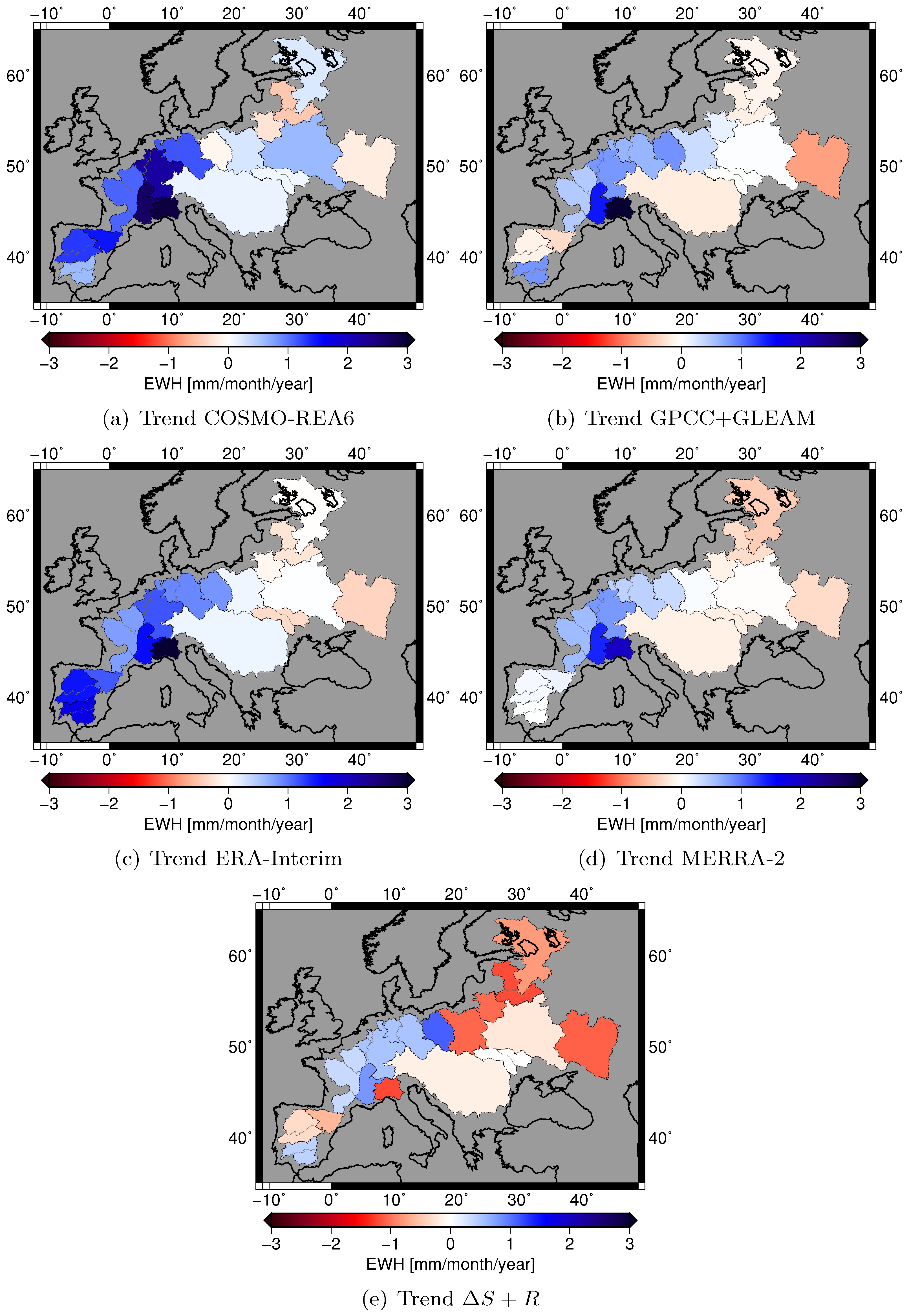
| Catchment | Size (km) | Catchment | Size (km) |
|---|---|---|---|
| Danube | 807,000 | Meuse-Rhine | 180,601 |
| Daugava-Narva | 120,500 | Neman | 81,200 |
| Dnepr | 463,000 | Neva | 281,000 |
| Don | 378,000 | Oder | 109,729 |
| Douro-Tagus | 158,981 | Po | 70,091 |
| Ebro | 84,230 | Rhone | 95,590 |
| Elbe-Ems-Weser | 178,039 | Southern Bug-Dniester | 112,300 |
| Garonne-Loire-Seine | 227,000 | Vistula | 194,376 |
| Guadalquivir-Guadiana | 107,878 |
| Catchment | Mean | Std. | RMSE | Bias | NS | NS |
|---|---|---|---|---|---|---|
| () | () | () | () | des., det. | ||
| Danube | 19.1 | 4.8 | 4.2 | 0.4 | 0.67 | −0.34 |
| Daugava | 18.0 | 7.9 | 9.1 | 0.9 | 0.60 | 0.28 |
| Dniester | 13.8 | 4.0 | 5.9 | −0.9 | 0.65 | 0.38 |
| Dnepr | 8.2 | 2.6 | 4.1 | −0.5 | 0.42 | 0.22 |
| Don | 4.8 | 1.7 | 2.1 | 0.2 | −0.12 | −0.22 |
| Douro | 11.0 | 2.9 | 6.2 | −1.0 | 0.61 | 0.45 |
| Ebro | 14.9 | 3.6 | 6.2 | 0.23 | 0.73 | 0.25 |
| Elbe | 11.9 | 3.1 | 4.2 | −0.1 | 0.69 | 0.17 |
| Ems | 28.3 | 5.6 | 9.8 | 1.6 | 0.84 | 0.49 |
| Garonne | 33.7 | 6.7 | 11.2 | 2.5 | 0.81 | 0.38 |
| Narva | 16.2 | 4.1 | 4.0 | 1.2 | 0.62 | 0.42 |
| Guadalquivir | 3.4 | 1.2 | 4.6 | −1.2 | 0.63 | 0.53 |
| Guadiana | 4.0 | 1.4 | 6.1 | −1.8 | 0.66 | 0.65 |
| Loire | 23.8 | 5.2 | 7.4 | 1.8 | 0.84 | 0.35 |
| Meuse | 35.2 | 7.4 | 11.0 | 1.7 | 0.84 | 0.50 |
| Neman * | 14.6 | 4.7 | 5.8 | −3.2 | 0.69 | 0.58 |
| Neva | 22.3 | 4.5 | 3.5 | −0.5 | 0.66 | −0.73 |
| Oder | 15.3 | 3.7 | 4.4 | 0.5 | 0.59 | 0.27 |
| Po | 61.4 | 16.4 | 20.4 | 4.0 | 0.51 | −0.11 |
| Rhine | 38.2 | 7.3 | 7.6 | 1.1 | 0.77 | 0.36 |
| Rhone | 51.1 | 11.8 | 10.6 | 1.7 | 0.76 | 0.45 |
| Southern Bug | 5.7 | 2.1 | 4.5 | −0.3 | 0.21 | 0.07 |
| Vistula * | 15.3 | 4.3 | 4.8 | −1.0 | 0.54 | 0.29 |
| Weser | 22.5 | 5.1 | 7.3 | 0.1 | 0.83 | 0.51 |
© 2017 by the authors. Licensee MDPI, Basel, Switzerland. This article is an open access article distributed under the terms and conditions of the Creative Commons Attribution (CC BY) license (http://creativecommons.org/licenses/by/4.0/).
Share and Cite
Springer, A.; Eicker, A.; Bettge, A.; Kusche, J.; Hense, A. Evaluation of the Water Cycle in the European COSMO-REA6 Reanalysis Using GRACE. Water 2017, 9, 289. https://doi.org/10.3390/w9040289
Springer A, Eicker A, Bettge A, Kusche J, Hense A. Evaluation of the Water Cycle in the European COSMO-REA6 Reanalysis Using GRACE. Water. 2017; 9(4):289. https://doi.org/10.3390/w9040289
Chicago/Turabian StyleSpringer, Anne, Annette Eicker, Anika Bettge, Jürgen Kusche, and Andreas Hense. 2017. "Evaluation of the Water Cycle in the European COSMO-REA6 Reanalysis Using GRACE" Water 9, no. 4: 289. https://doi.org/10.3390/w9040289






